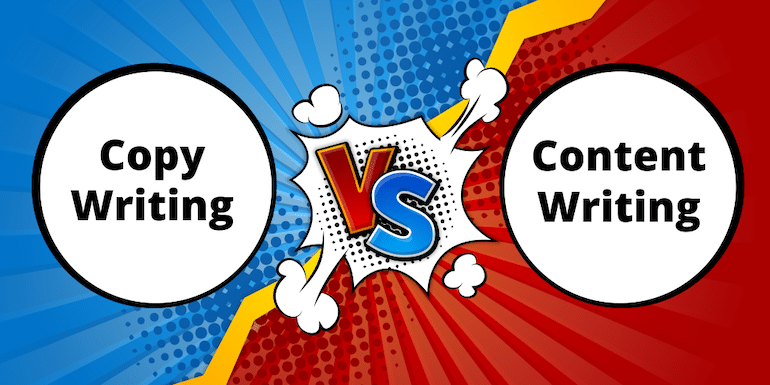What is the difference between content writing and copywriting? More important what one should be writing content or copy?

The difference between Content Writing and Copywriting lies in the purpose. To put it simply, content writing is an information form of writing. Whereas, copywriting is a persuasive form of writing where you want the readers to lure into some action.
Online Writing Styles
One can find online content written in 5 different styles. Expository, descriptive, narrative, persuasive and creative. Each writing types convey different meaning & context.
Let’ take a quick look into each writing style.
- Expository – This is the most common type of writing. Here, the writer tries to inform, explain, describe or define a subject to the reader. Example, How-to articles. How to build a website, How to start a blog, etc.
- Descriptive – The descriptive form of writing explains the subject in great detail. The writer uses attractive visuals in his/her write-ups. These visuals help readers to create a picture of a person, place or thing in their mind. For example, reporting an event.
- Narrative – This type of writing is commonly found in novels, stories or biographies. It includes plots and storylines to talk to the reader. It’s an entertaining form of writing. For example, fictional stories.
- Persuasive – It leads the reader to action. Focuses on problem-solving with unbiased recommendations. The persuasive writing style is mainly used in advertisements and commercials to sell a product or service. For example, product review, book review, movie review, etc.
- Creative – Creative writing includes creativity and subject expertise blend together. The main ingredient of creative writing is to trap the interest of the reader. It can be done to write a story or an advertisement.
Now that we know the basic difference let’s drill down to the bottom line.
What is Content Writing?
Content means information. It’s a form of online writing. Further, content on the internet is available in a variety of formats.
It could be in the form of a blog, website, social media post, tweet, bio, podcast, PDF, eBook, video, GIF or infographic. Anyone who writes such content is a content writer.
Types of Content Written Online
Online content is written with intention and purpose. It speaks directly with the audience to inform, educate or entertain them.
The writer integrates data, charts, case studies, graphs and lot more to effectively convey the idea in content. This further establishes the credibility of written content.
Let’s look at the types of content available online.
- Website Content – For example home page, landing page, about us, contact, terms, condition, privacy policy, etc.
- Blogs & Articles – For example, how to make money online, what is a blog, and what is blogging.
- eCommerce Content – For example, product title, product description, key features, and benefits.
- SEO Content – SEO copywriting focuses on creating content that will rank higher in search engine organic results. An SEO copywriter compiles content and inserts relevant keywords to make the content search-friendly. One needs to take care of readability score, subheading distribution, paragraph, and sentence length too. For example, meta tags, excerpts, snippets, keywords, and image alt tags.
- Technical Content – For example, product demo, manuals, and installation process.
What is Copywriting?
Copywriting is a form of content writing but with an intention to help the reader to take action. It is otherwise called sales copywriting which integrates the psychology of persuasion.
The one who writes actionable content (mostly for sales or generating) is a copywriter.
So any type of content written with an intention for a user to take any action is copywriting.
Types of Copywriting
Below I have mentioned 5 types of copywriting.
- Marketing Copywriting – A marketing copywriting includes emails for readers to take direct action.
- Advertisement Copywriting – Type if marketing copywriting but writing ad copies for PPC campaigns in Google Ads.
- Creative Copywriting – Creative copywriters are storytellers. Copywriter tells a story or even create a story around the product or services they intend to sell. The motive behind creative copywriting is to strike a chord with customers. Creative copywriting examples include online commercials and video ads.
- Technical Copywriting – Technical copywriting is limited to a specific industry or technology. The target is to promote & sell technology products or services. For example, a technical copywriter would create content for a software, plugin, digital tool, etc.
Don’ts of Copywriting?
Avoid highly aggressive content or use of scammy tactics and blatant lies to sell. Here is a list of fishy techniques used by copywriters:
- Blatantly lie
- Put pressure to buy
- Use scare tactics
- Generate fear to sell
- Falsely claim that is untrue
- Keep pushing you to buy
- Don’t care about refunds or returns
- Manipulate the truth to sell
This kind of marketing doesn’t work in the long run. Buyers are smart, they read, check all the aspects and then decide whether they should buy or not.
In fact, pointing out the weak points of a product sounds more honest instead of hiding them.
People like to read content that is leading them. They want to be educated. They want someone to tell them the pros and cons of a product in an honest manner.
The Do’s of Copywriting
Here are some of the dos every copywriter must incorporate in his copy.
- Honest.
- Contain useful information about the product
- Have unbiased recommendations
- Be helpful to the reader in making an informed purchase decision
- Cover all pros and cons about the product
- Lead and educate buyers without offending them
There’s nothing wrong with recommending a product or service to an audience and earning out of it. In fact, it works the other way round.



